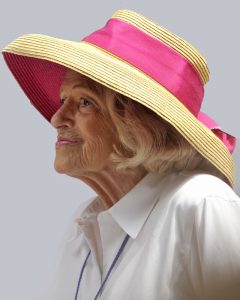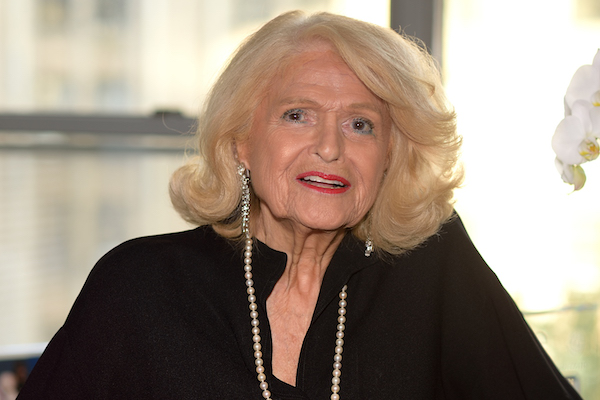This year’s celebration of Pride is situated in a markedly different political climate than the one we celebrated a year ago. In a capital occupied by the Trump Administration, Pride takes on a sense of urgency that our community hasn’t felt in recent years. So while we come to Pride to celebrate ourselves and our community, we come also to stand up against hate and intolerance.
If anyone embodies this spirit, it’s Edie Windsor. Best known for winning the 2013 Supreme Court case that struck down the Defense of Marriage Act (DOMA), Windsor is this year’s Capital Pride grand marshal.
“Our current message is different from prior years,” Windsor tells me over the phone, describing what she hopes to communicate during Pride. “My message today is that of community and strength.”
It’s an important message, one that serves as a reminder not only to those who wish to encroach upon our rights and wellbeing, but also to ourselves.
“I don’t want young LGBTQ people to feel hopeless anymore,” Windsor says. “If we look out at progress over the past 20 years, 10 years, even five years, it’s been huge—and nobody can turn that around.”
Events like Stonewall, the AIDS crisis, and the recent wave of Supreme Court cases dealing with LGBTQ rights have created a more visible LGBTQ community, brought it closer together, and fostered queer visibility not just outside of the community but also within it. As more people came out over the years, Windsor says, “We saw each other and loved what we saw.”
Windsor wants young LGBTQ people to see older members of the community as a powerful resource. “We want everybody young and everybody new to understand [that] we’re armed to give advice and to help newcomers—we want them to join. Don’t be afraid to call up, to letter—anything,” she says.
She also has a message for Donald Trump himself, and it’s diplomatic and inviting.
“Sir, you have a chance to make history,” she’d say if she had the chance to meet with him individually. If Trump could give up his far right influence— “the wrong kind of influence,” she says—and could love immigrants and LGBTQ people, “I think we would all join you in a way that may turn you into one of the greatest presidents we ever had in this country. Stop all the hate, and see us as who we are—which is really quite loveable.”
THE EARLY LIFE OF EDIE WINDSOR
Windsor has seen a dramatic shift in attitudes toward LGBTQ individuals over the course of her lifetime. Born in 1929, homosexuality wasn’t a concept Windsor was familiar with until she was in college, in the late 1940s. During this time, she became aware of her sexual orientation, but she somewhat resisted the idea of being gay. A romantic relationship with a female classmate caused Windsor to end her engagement to her older brother’s best friend, but not wanting to live her life as a gay person, she reconciled with the man, whom she married in 1951.

The marriage did not last. Less than a year after they wed, they divorced. “He deserved more. He deserved somebody who thought he was absolutely everything,” Windsor told Time magazine in 2013. “I left. I told him I needed something else.”
At 23 years old, the newly single Windsor moved from Philadelphia, where she had grown up and attended college, to Greenwich Village, where she began to pursue her master’s in applied mathematics at New York University.
Taking computing classes, she quickly excelled in the emerging, male-dominated field of computer programming. During this time, she also began to find her way into New York’s large but underground gay community. Finding this community proved tricky for the relatively conservative young Windsor, as was attracting the interest of other lesbians, so for her first two years in New York, she spent much of her time with gay men. However, she eventually began to discover where the lesbians were, and went dancing at gay bars nearly every night.
Windsor earned her master’s in 1955 and began to work for IBM three years later. There, she found both professional and social success: she ascended the ranks to become a Senior Systems Programmer—a rare title held by few in the company.
In 1965, Windsor started dating Thea Spyer, a ravishing psychologist she had met two years earlier. As the two women began to fall for each other, Windsor felt it was necessary to keep their relationship a secret at work. “Once there was Thea, I wasn’t going to go to the weekend wine tasting alone, and I wasn’t going to bring her that’s for sure,” she told me.
In 1967, Windsor and Spyer got engaged, even though they could not legally wed.
“It just happened,” Windsor recalls of the engagement in the video, “Edie and Thea: A Love Story,” produced by Time. “Thea decided to do that, and we were driving out to the Hamptons, and she started talking about, ‘Well what would you do if you were to become engaged?’”
“And I said, ‘Well I couldn’t wear a ring because all my friends at work would need to know.”
“By the time we reached our destination, she had conned me into saying, ‘It could be a brooch of a circle of diamonds,’” Windsor told me.
“We got out of the car, she got down on one knee, and she said, ‘Edie Windsor, will you marry me,’ and she pulled out a circle brooch with diamonds.”
“’Yes, yes,’ I said, and she was annoyed because I wouldn’t let her finish her sentence.”
“A VERY LONG ENGAGEMENT”
While their relationship was relatively hidden for the next couple of decades, Windsor and Spyer captivated each other and lived fulfilling lives. They had a supportive circle of close friends and successful careers. Spyer built her own psychology practice, and saw patients up until she passed away in 2009. Windsor continued working at IBM until 1977, when the company was moving her work outside of New York City. She utilized her early retirement to travel and volunteer for LGBTQ organizations, including SAGE.
Windsor and Spyer had the opportunity to get married in 2007, 40 years after Thea had proposed. Same-sex marriage was not yet legal in New York, where they lived, but it was legal in Canada. Spyer’s health was failing at this time; living with multiple sclerosis for several years had made her quadriplegic, and with an ailing heart, she had recently received a prognosis of less than a year to live. So along with three close women friends and two best men, the couple traveled to Toronto and were wed on May 22, as documented in Edie and Thea: A Very Long Engagement.
After their wedding announcement ran in The New York Times, hundreds of people from all stages of their lives, including many who hadn’t known about their relationship, wrote to congratulate them.
In 2009, Thea Spyer died peacefully at home. Devastated, Windsor suffered from two heart attacks soon after. Lying in the hospital, she couldn’t imagine what she would do with the rest of her life. However, the Edie and Thea documentary was gaining traction and film festivals worldwide. Windsor was able to travel and speak at these festivals, giving her a renewed sense of life and a taste of the public attention that was soon to come.


